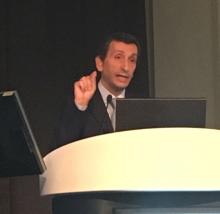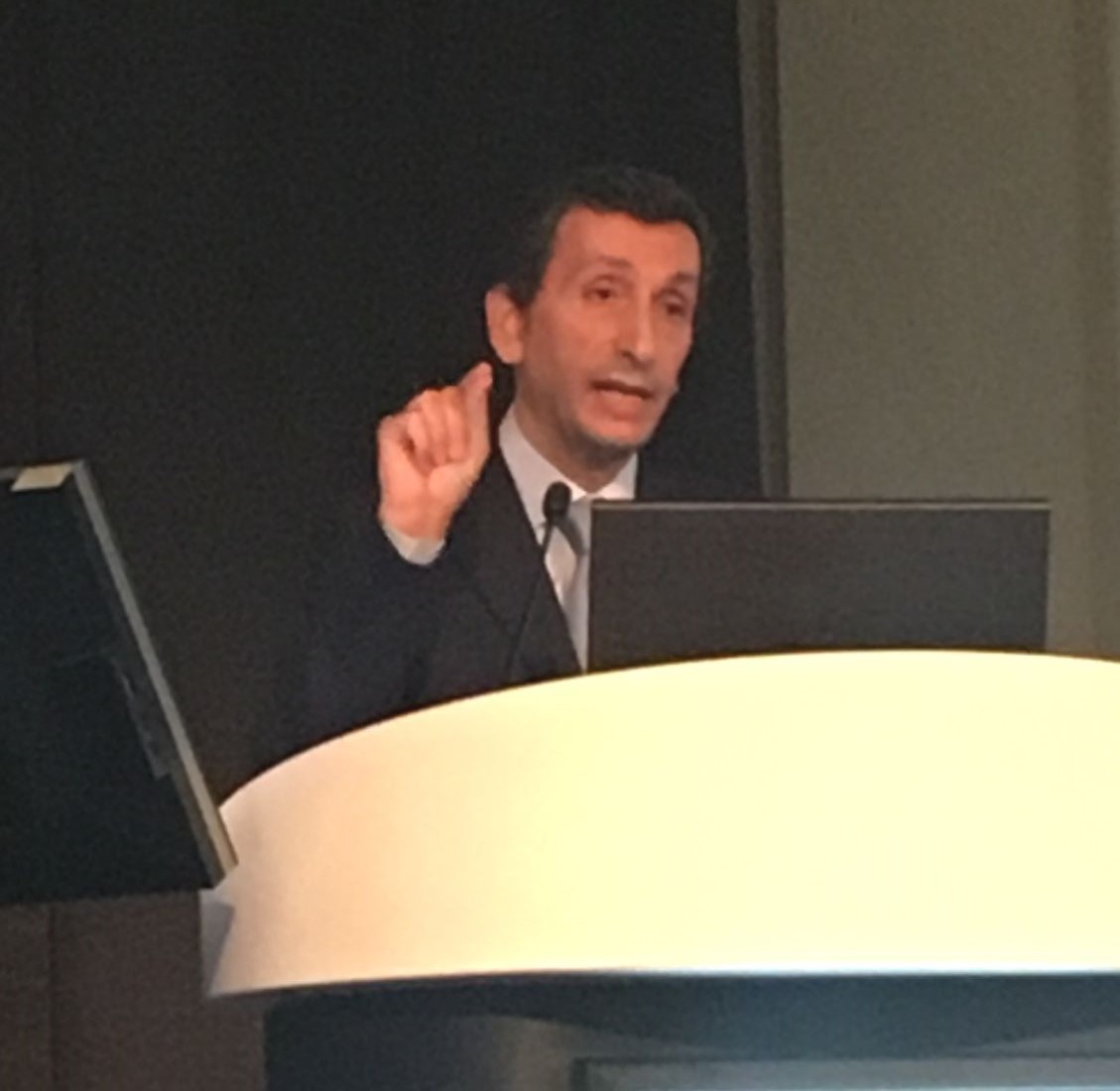User login
SAN DIEGO – Autologous stem cell transplantation outperformed bortezomib-based intensification in fit patients younger than 66 years of age with newly diagnosed multiple myeloma, based on a prespecified interim analysis of 1,192 patients from a randomized phase III trial.
After a median follow-up of 32 months, median progression-free survival (PFS) had not been reached among patients who received high-dose melphalan plus single or double autologous stem cell transplantation, but was 42.5 months among patients who instead received standard-dose bortezomib-melphalan-prednisone (VMP), Michele Cavo, MD, reported at the annual meeting of the American Society of Hematology. Three-year rates of progression free survival were 65% with ASCT and 57% with VMP (hazard ratio, 0.73; 95% confidence interval, 0.61-0.88; P = .001), he reported.
There was a trend toward better outcomes with double ASCT instead of single ASCT, said Dr. Cavo of Bologna (Italy) University. At 3 years, PFS rates were 74% with double ASCT and 62% with single ASCT (HR, 0.7; P = .05).
The effect was stronger among patients with high-risk cytogenetics, for whom 3-year PFS rates were 65% and 41% (HR, 0.49; P = .046). Those patients had median PFS times of 47 months and 27 months, respectively, Dr. Cavo said. In a multivariable analysis, double ASCT also reduced the chances of death or progression by about 35% compared with single ASCT, even after controlling for high-risk cytogenetics, age, and other risk factors for poor prognosis (HR, 0.65; P = .03).
This is the first trial of its type to prospectively compare single and double ASCT with a novel myeloma regimen, according to Dr. Cavo. The data are not yet mature enough to support firm conclusions, but do highlight the role of ASCT in the bortezomib era and the potential for double ASCT to benefit patients with poor prognostic risk factors, particularly high-risk cytogenetics, he said.
The EMN02/HO95 trial enrolled more than 1,500 patients aged 18-65 years with symptomatic, newly diagnosed multiple myeloma. Patients underwent induction therapy with three to four cycles of bortezomib plus cyclophosphamide and dexamethasone (VCD), and then were randomly assigned to either high-dose melphalan (200 mg/m2) plus single or double ASCT, or to four cycles of bortezomib (1.3 mg/m2), melphalan (9 mg/m2), and prednisone (60 mg/m2; VMP). Patients were then re-randomized to receive lenalidomide maintenance alone or after consolidation with two cycles of bortezomib, lenalidomide, and dexamethasone (VRD).
This prespecified analysis was triggered in early November 2016, when 33% of required events occurred. Future analyses will examine the effects of consolidation as well as safety, toxicity, and quality of life, Dr. Cavo noted.
Celgene and Janssen provided funding for the study. Dr. Cavo disclosed ties to Celgene, Janssen, Takeda, Bristol-Myers Squibb, and Amgen.
SAN DIEGO – Autologous stem cell transplantation outperformed bortezomib-based intensification in fit patients younger than 66 years of age with newly diagnosed multiple myeloma, based on a prespecified interim analysis of 1,192 patients from a randomized phase III trial.
After a median follow-up of 32 months, median progression-free survival (PFS) had not been reached among patients who received high-dose melphalan plus single or double autologous stem cell transplantation, but was 42.5 months among patients who instead received standard-dose bortezomib-melphalan-prednisone (VMP), Michele Cavo, MD, reported at the annual meeting of the American Society of Hematology. Three-year rates of progression free survival were 65% with ASCT and 57% with VMP (hazard ratio, 0.73; 95% confidence interval, 0.61-0.88; P = .001), he reported.
There was a trend toward better outcomes with double ASCT instead of single ASCT, said Dr. Cavo of Bologna (Italy) University. At 3 years, PFS rates were 74% with double ASCT and 62% with single ASCT (HR, 0.7; P = .05).
The effect was stronger among patients with high-risk cytogenetics, for whom 3-year PFS rates were 65% and 41% (HR, 0.49; P = .046). Those patients had median PFS times of 47 months and 27 months, respectively, Dr. Cavo said. In a multivariable analysis, double ASCT also reduced the chances of death or progression by about 35% compared with single ASCT, even after controlling for high-risk cytogenetics, age, and other risk factors for poor prognosis (HR, 0.65; P = .03).
This is the first trial of its type to prospectively compare single and double ASCT with a novel myeloma regimen, according to Dr. Cavo. The data are not yet mature enough to support firm conclusions, but do highlight the role of ASCT in the bortezomib era and the potential for double ASCT to benefit patients with poor prognostic risk factors, particularly high-risk cytogenetics, he said.
The EMN02/HO95 trial enrolled more than 1,500 patients aged 18-65 years with symptomatic, newly diagnosed multiple myeloma. Patients underwent induction therapy with three to four cycles of bortezomib plus cyclophosphamide and dexamethasone (VCD), and then were randomly assigned to either high-dose melphalan (200 mg/m2) plus single or double ASCT, or to four cycles of bortezomib (1.3 mg/m2), melphalan (9 mg/m2), and prednisone (60 mg/m2; VMP). Patients were then re-randomized to receive lenalidomide maintenance alone or after consolidation with two cycles of bortezomib, lenalidomide, and dexamethasone (VRD).
This prespecified analysis was triggered in early November 2016, when 33% of required events occurred. Future analyses will examine the effects of consolidation as well as safety, toxicity, and quality of life, Dr. Cavo noted.
Celgene and Janssen provided funding for the study. Dr. Cavo disclosed ties to Celgene, Janssen, Takeda, Bristol-Myers Squibb, and Amgen.
SAN DIEGO – Autologous stem cell transplantation outperformed bortezomib-based intensification in fit patients younger than 66 years of age with newly diagnosed multiple myeloma, based on a prespecified interim analysis of 1,192 patients from a randomized phase III trial.
After a median follow-up of 32 months, median progression-free survival (PFS) had not been reached among patients who received high-dose melphalan plus single or double autologous stem cell transplantation, but was 42.5 months among patients who instead received standard-dose bortezomib-melphalan-prednisone (VMP), Michele Cavo, MD, reported at the annual meeting of the American Society of Hematology. Three-year rates of progression free survival were 65% with ASCT and 57% with VMP (hazard ratio, 0.73; 95% confidence interval, 0.61-0.88; P = .001), he reported.
There was a trend toward better outcomes with double ASCT instead of single ASCT, said Dr. Cavo of Bologna (Italy) University. At 3 years, PFS rates were 74% with double ASCT and 62% with single ASCT (HR, 0.7; P = .05).
The effect was stronger among patients with high-risk cytogenetics, for whom 3-year PFS rates were 65% and 41% (HR, 0.49; P = .046). Those patients had median PFS times of 47 months and 27 months, respectively, Dr. Cavo said. In a multivariable analysis, double ASCT also reduced the chances of death or progression by about 35% compared with single ASCT, even after controlling for high-risk cytogenetics, age, and other risk factors for poor prognosis (HR, 0.65; P = .03).
This is the first trial of its type to prospectively compare single and double ASCT with a novel myeloma regimen, according to Dr. Cavo. The data are not yet mature enough to support firm conclusions, but do highlight the role of ASCT in the bortezomib era and the potential for double ASCT to benefit patients with poor prognostic risk factors, particularly high-risk cytogenetics, he said.
The EMN02/HO95 trial enrolled more than 1,500 patients aged 18-65 years with symptomatic, newly diagnosed multiple myeloma. Patients underwent induction therapy with three to four cycles of bortezomib plus cyclophosphamide and dexamethasone (VCD), and then were randomly assigned to either high-dose melphalan (200 mg/m2) plus single or double ASCT, or to four cycles of bortezomib (1.3 mg/m2), melphalan (9 mg/m2), and prednisone (60 mg/m2; VMP). Patients were then re-randomized to receive lenalidomide maintenance alone or after consolidation with two cycles of bortezomib, lenalidomide, and dexamethasone (VRD).
This prespecified analysis was triggered in early November 2016, when 33% of required events occurred. Future analyses will examine the effects of consolidation as well as safety, toxicity, and quality of life, Dr. Cavo noted.
Celgene and Janssen provided funding for the study. Dr. Cavo disclosed ties to Celgene, Janssen, Takeda, Bristol-Myers Squibb, and Amgen.
AT ASH 2016
Key clinical point: Autologous stem cell transplantation outperformed bortezomib-based intensification in patients with newly diagnosed multiple myeloma.
Major finding: Progression-free survival at 3 years was 65% with melphalan plus ASCT and 57% with bortezomib, melphalan, and prednisone (HR, 0.73; P = .001).
Data source: An interim analysis of a phase III study of 1,510 patients with newly diagnosed multiple myeloma.
Disclosures: Celgene and Janssen provided funding. Dr. Cavo disclosed ties to Celgene, Janssen, Takeda, Bristol-Myers Squibb, and Amgen.

